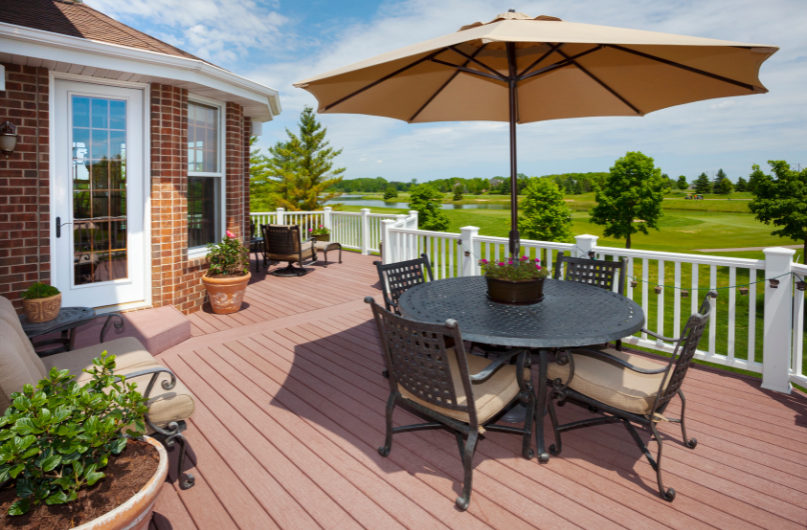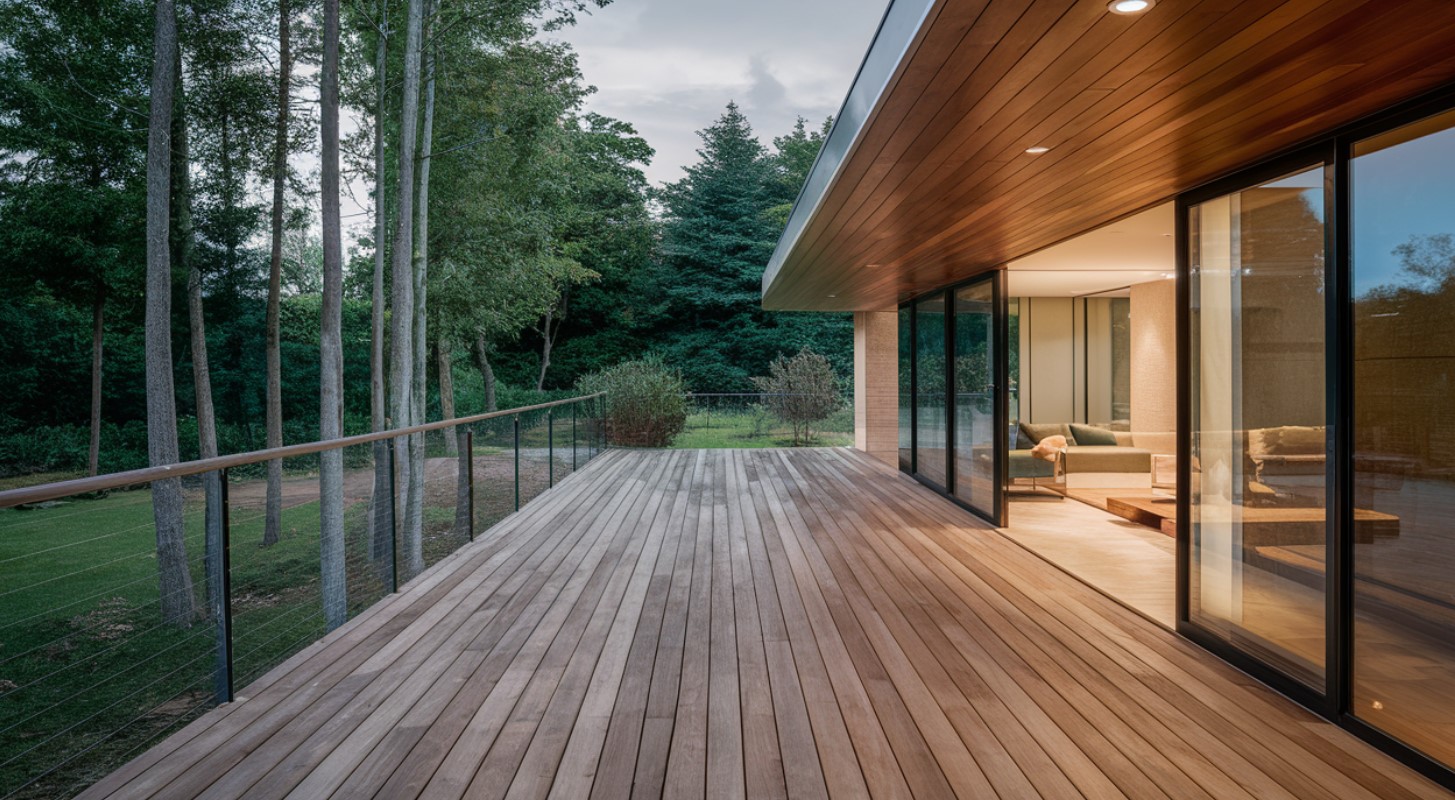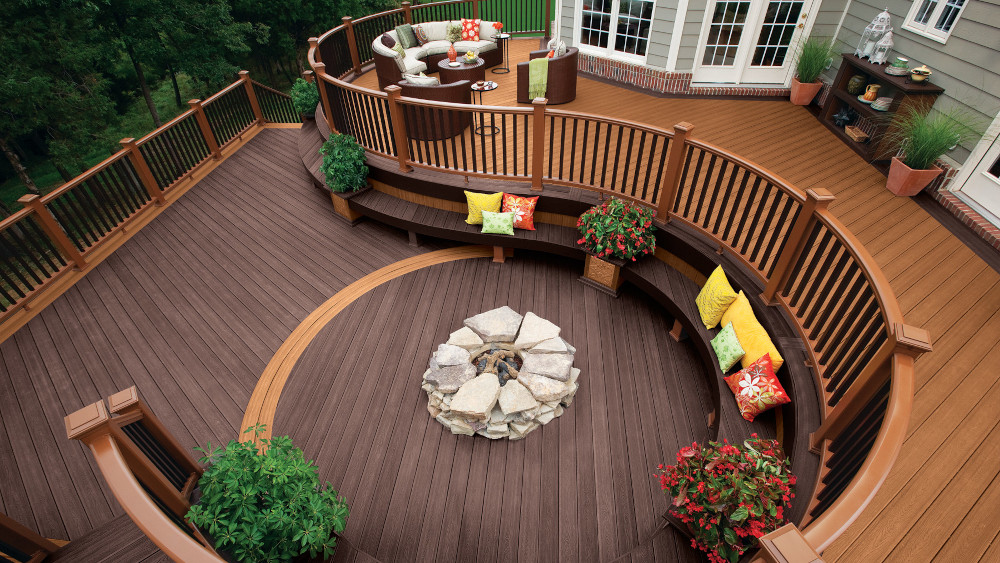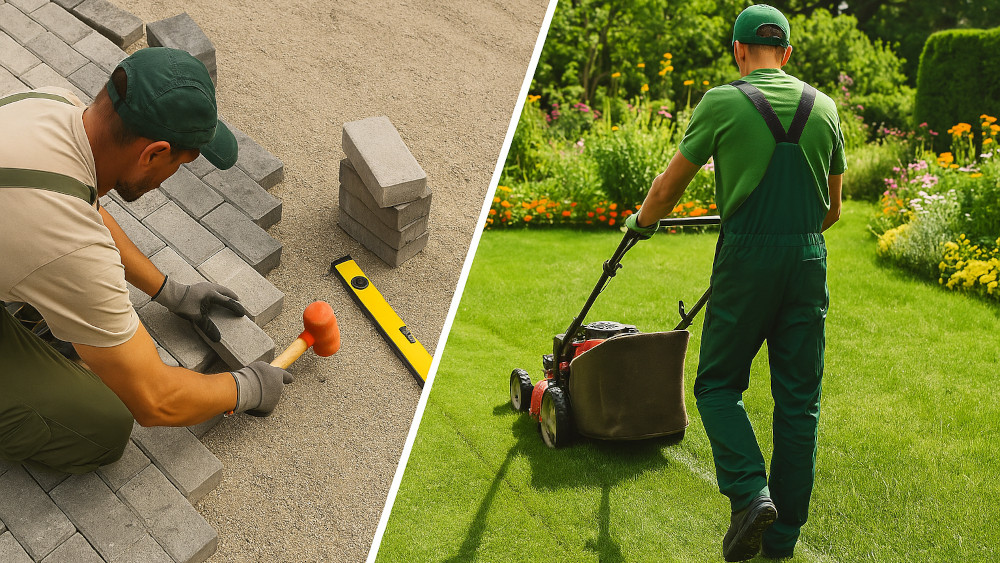When you’re deciding between composite decking and traditional wood decking, it’s crucial to weigh their pros and cons carefully. Composite decking offers durability, low maintenance, and eco-friendly benefits but comes with a higher upfront cost and potential heat retention issues. On the flip side, wood decking gives you a natural look and customization options but demands more upkeep and has a shorter lifespan. So, which one fits your needs better? Let’s explore each aspect in more detail to help you make an informed decision.
Main Points
- Composite decking offers superior resistance to rot, mold, and insects compared to traditional wood.
- Traditional wood decking provides a natural appearance with unique grain patterns, unlike the more uniform look of composite decking.
- Composite decking requires significantly less maintenance, saving time and effort over its lifespan.
- Traditional wood decks have higher long-term maintenance costs due to staining, sealing, and repairs.
- Composite decking utilizes recycled materials, making it a more eco-friendly and sustainable choice.
Understanding Decking Materials
When choosing decking materials, you’ll need to understand the basics of both composite and traditional wood options.
Composite decking, made from a mix of wood fibers and recycled plastic, offers durability and low maintenance.
Conversely, wood decking, using types like Pine, Kwila, and Vitex, provides a natural look but requires regular upkeep.
Explanation of composite decking
Composite decking, made from a blend of recycled wood fibers and plastic, provides a durable and low-maintenance alternative to traditional wood decking. When considering the installation process, you’ll find it straightforward due to uniformity in board size and shape. This consistency helps reduce the challenge of fitting, cutting, and aligning the decking materials.
Durability factors make composite decking a superior choice. It’s resistant to rot, warping, and splintering, ensuring your deck remains safe and visually appealing for years. Its eco-friendly benefits can’t be overlooked either; using recycled materials greatly reduces environmental impact.
Customization options abound with composite decking. You can choose from a variety of colors, textures, and finishes to match your aesthetic preferences. Additionally, many manufacturers offer extensive warranty coverage, giving you peace of mind and protecting your investment.
Here’s a quick comparison table to visualize composite decking’s features:
| Feature | Composite Decking |
| Durability | High resistance to rot, warping, splintering |
| Eco-Friendly | Made from recycled materials |
| Customization | Wide range of colors and finishes |
What is composite decking?
Understanding composite decking begins with acknowledging that it combines wood fibers and recycled plastic to create a durable and low-maintenance alternative to traditional wood decking. By blending these materials, you get a product that’s resistant to common issues like rot, warping, and splintering.
When it comes to the installation process, composite decking can be easier to handle than wood. It often features interlocking systems that make the assembly straightforward. Plus, these boards come in various color and texture options, allowing you to customize your deck’s appearance to suit your style.
One of the standout eco-friendly features of composite decking is its use of recycled materials. This makes it a sustainable choice for those looking to minimize their environmental footprint. In terms of durability comparison, composite decking outperforms wood by resisting weathering and insect damage, ensuring a longer lifespan.
Maintenance requirements are lower with composite decking. There’s no need for regular sanding, staining, or painting—simple soap and water are usually enough to keep it looking pristine. This low-maintenance nature, combined with its aesthetic flexibility and durability, makes composite decking an excellent choice for your outdoor living space.

Common materials used in composite decking
You’ll find that composite decking is made from a blend of wood fibers, plastic, and binding agents, which together create a highly durable and low-maintenance option for your outdoor spaces. These materials give composite decking its impressive resistance to rot, mold, and insects, distinguishing it from traditional wood.
| Material | Key Benefits | Considerations |
| Wood Fibers | Natural look, eco-friendly | Can affect color options |
| Plastic | Durability, low maintenance | Environmental impact |
| Binding Agents | Enhanced strength, stability | Installation process |
The combination of these materials results in a product with significant environmental impact benefits. Composite decking often utilizes recycled wood and plastic, making it a more sustainable choice. Concerning color options, composite boards offer a wide range, allowing you to find the perfect match for your aesthetic needs.
When comparing durability, composite decking stands out due to its ability to withstand harsh weather without warping or splintering. This durability comparison shows a clear advantage over traditional wood. Finally, the maintenance requirements are minimal; a simple wash is usually enough to keep your deck looking pristine.
Explanation of traditional wood decking
When contemplating traditional wood decking, how do its natural aesthetics and tactile appeal measure up against the need for regular maintenance?
The allure of wood decking lies in its authentic wood characteristics and natural appearance. These elements provide a timeless charm that many homeowners find irresistible. However, embracing wood decking means committing to its maintenance requirements.
You’ll need to stain and seal your deck regularly to protect it from weathering and decay. Unlike composite boards, wood is susceptible to rot, warping, and splintering, which can compromise its durability over time. Regular inspections for insect damage and prompt repairs of any defects, such as knots or breaks, are crucial to maintain its integrity.
Durability concerns are another aspect to take into account. While the initial investment might be lower, the long-term sustainability of wood decking is questionable due to its susceptibility to environmental elements. Ensuring your deck remains in good condition will require consistent effort and resources.
Types of wood commonly used for decking in New Zealand (e.g., Pine, Kwila, Vitex)
Exploring the types of wood commonly used for decking in New Zealand, you’ll find options like Pine, Kwila, and Vitex, each offering distinct advantages. When making a wood comparison, Pine stands out for its affordability and easy availability, making it a popular choice for many decking projects. It’s a softwood, so while it’s important to consider, it may not be as durable as other options.
Kwila, however, is known for its durability and natural resistance to decay. This hardwood is a reliable option if you’re looking for decking options that can withstand New Zealand’s varying weather conditions. Kwila’s rich, reddish-brown color also provides a beautiful aesthetic choice for your outdoor space.
Vitex offers a sustainable and robust alternative. This hardwood is favored for its strength and resistance to insect damage, making it a top pick for those who prioritize durability factors. Its lighter color can brighten up any deck, adding a touch of elegance.
Understanding these material preferences is important for selecting the most suitable wood for your decking needs. Balancing cost, durability, and aesthetic choices will help you achieve a deck that’s both functional and visually appealing.
Pros of Composite Decking
Composite decking stands out for its impressive durability and longevity, making it a reliable choice for outdoor spaces. One of the primary durability benefits is its resistance to weather, rot, and insects, ensuring that your deck remains in top condition for years. This weather resistance translates into a longevity advantage, as composite materials don’t warp, splinter, or require frequent replacements like traditional wood.
If you’re environmentally conscious, composite decking is an eco-friendly option. Many composite boards are made from recycled materials, reducing waste and promoting sustainability. This makes it a greener choice compared to conventional wood decking, which often involves deforestation.
In terms of maintenance, composite decking is incredibly low-maintenance. You won’t need to spend time and money on staining, painting, or sealing. A simple wash with soap and water is usually enough to keep it looking pristine.
Additionally, composite decking offers aesthetic versatility. You can choose from a range of colors and finishes that maintain a consistent appearance over time, without the fading or discoloration that plagues wood decks.
This combination of low maintenance, durability, and eco-friendliness makes composite decking a smart investment for any outdoor space.
Cons of Composite Decking
Although composite decking has many advantages, it does come with some notable drawbacks. First, the upfront costs can be considerably higher compared to traditional wood. This initial investment might be a deterrent if you’re working with a tight budget.
Another issue is scratch susceptibility. Heavy furniture or sharp objects can easily leave marks on the deck’s surface, diminishing its aesthetic appeal. While composite decking is typically durable, these scratches can be more noticeable and harder to repair than scratches on wood.
Heat retention is another concern, especially in sunny climates. Composite materials tend to absorb and retain heat, making the surface uncomfortably hot underfoot during peak sunlight hours. This can limit the usability of your deck on particularly warm days.
Appearance concerns also come into play. Despite advances in technology, composite decking mightn’t fully replicate the natural look and feel of wood. Some homeowners prefer the authentic and unique grain patterns that wood offers, which composites often lack.
Lastly, while composite decking boasts lower maintenance requirements overall, it’s not maintenance-free. You’ll still need to clean it regularly to prevent mold and mildew buildup, ensuring it retains its visual appeal.
Pros of Traditional Wood Decking
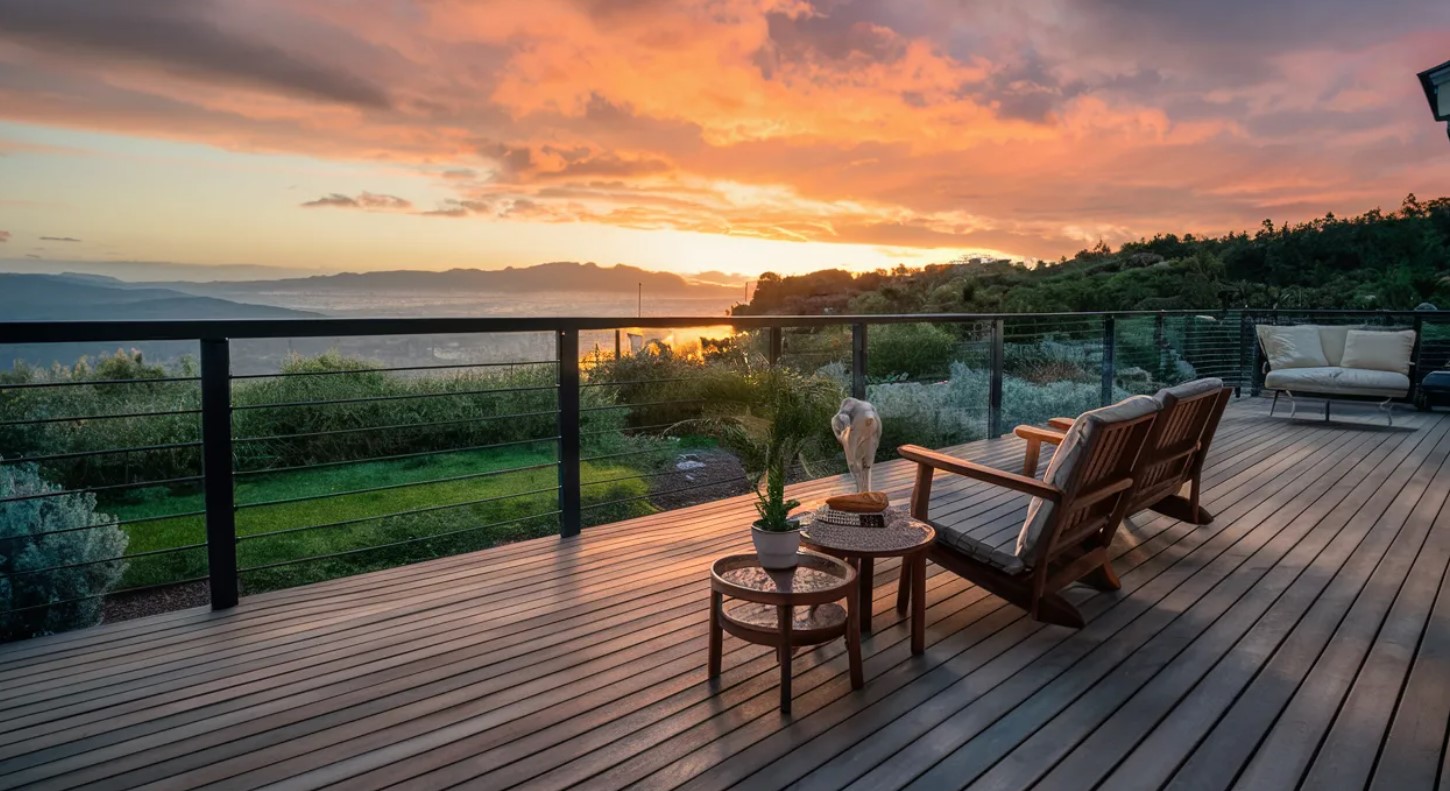
Traditional wood decking offers several advantages that make it an appealing choice for many homeowners. Its natural appearance is one of the most attractive features. Wood’s authentic look and feel, along with its unique grain patterns, can add a timeless charm to your outdoor space.
In terms of durability comparison, traditional wood can last for many years if maintained properly, although it requires more attention than composite decking. Customization options are another strong point. Wood is easier to cut and shape, allowing you to create custom designs and intricate layouts with relative ease. This flexibility can be particularly useful if you have a specific vision for your deck.
Maintenance requirements are higher with wood, but many homeowners find the trade-off worthwhile for the natural aesthetic it provides. Regular sanding, staining, and sealing can preserve its beauty and longevity.
From an environmental impact perspective, wood is a biodegradable material, meaning it can decompose naturally. This makes it a more eco-friendly option compared to synthetic materials.
In essence, traditional wood decking combines a natural appearance with customizable options, making it a versatile and environmentally conscious choice for your home.
Cons of Traditional Wood Decking
Maintaining a wood deck requires regular staining and sealing to keep it from rotting or succumbing to mold and insect damage. These maintenance requirements can be time-consuming and costly. Wood decks are also more prone to splintering over time, posing significant safety concerns, particularly for families with young children or pets.
Furthermore, natural wood is highly susceptible to pest damage. Termites and other wood-destroying insects can wreak havoc, necessitating frequent treatments and inspections. Comparatively, wood decking has a shorter lifespan than composite decking, often leading to more frequent repairs and replacements. This reduces its long-term value and increases the overall investment needed to maintain it.
| Issue | Traditional Wood Decking | Composite Decking |
| Maintenance | High | Low |
| Safety Concerns | Splintering risks | Minimal |
| Pest Susceptibility | High | Low |
| Lifespan Comparison | Shorter | Longer |
While the initial cost of wood decking may seem attractive, you’ll find that the ongoing maintenance and potential for frequent replacements can outweigh those initial savings. By understanding these cons, you can make a more informed decision about the best decking material for your needs.
Cost Comparison
When comparing costs, you’ll notice composite decking has a higher initial price than wood, but it’s crucial to take into account long-term expenses. Over time, wood requires frequent maintenance, which can add up, making composite a potentially more cost-effective option in the long run.
Additionally, composite decking may improve your home’s resale value, providing further financial benefits.
Initial Costs vs. Long-Term Investment
Comparing initial costs, composite decking comes with a higher price tag than wood, but its long-term savings and durability make it a worthwhile investment. When you perform a cost analysis, you’ll notice that composite decking costs more than wood. Although the initial expenses for composite are higher, the financial benefits you’ll reap over time are significant.
Here’s a breakdown:
- Investment comparison: Composite decking demands a higher upfront investment but results in fewer expenses over time.
- Long-term savings: Unlike wood, composite decking doesn’t require regular sanding, varnishing, or painting, reducing future costs.
- Durability: Composite materials are resistant to rot, warping, and splintering, ensuring they last longer and maintain their appearance.
- Maintenance: With minimal upkeep, composite decking saves you both time and money in the long run.
- Return on investment: Homes with composite decking often see a higher resale value, offsetting the initial cost.
Maintenance Costs Over Time
Over time, you’ll find that composite decking greatly reduces maintenance costs compared to traditional wood. With composite decking, you won’t need to constantly sand, varnish, or paint, which leads to significant maintenance savings. The longevity benefits of composite decking can’t be overstated; it resists rot, warping, and splintering, reducing repair expenses dramatically.
In a cost analysis, the durability comparison between composite and wood is clear. While wood may initially seem cheaper, the ongoing costs of upkeep can add up. Composite decking, with its low water absorption and insect resistance, prevents mold and rot issues, further decreasing your maintenance costs.
Here’s a quick comparison:
| Factor | Composite Decking | Wood Decking |
| Maintenance Savings | High (minimal upkeep needed) | Low (requires frequent maintenance) |
| Longevity Benefits | Long-lasting (resistant to damage) | Shorter lifespan (prone to issues) |
| Repair Expenses | Low (rarely needs repair) | High (frequent repairs needed) |
Potential Resale Value
Investing in composite decking can greatly boost your home’s resale value due to its low maintenance and long-lasting durability. Market trends indicate that potential buyers are increasingly attracted to the benefits offered by composite decking, which can substantially increase your home value.
In terms of resale potential, composite decking stands out for several reasons:
- Low Maintenance: Buyers appreciate not having to worry about frequent upkeep, which improves buyer appeal.
- Durability: The long-lasting nature of composite decking guarantees that it remains in good condition, making it a strong selling point.
- Aesthetic Appeal: Composite decking maintains its look over time, which adds to the overall attractiveness of your property.
- Higher ROI: While the initial costs may be higher, the investment return is often greater due to lower maintenance and repair costs.
- Market Demand: Current market trends show a growing preference for composite materials in home improvement projects.
Considering these factors, it’s evident that composite decking can positively impact your home’s resale potential. By choosing composite over traditional wood, you’re making a smart investment that pays off in both the short and long term, improving your home’s market appeal and value.
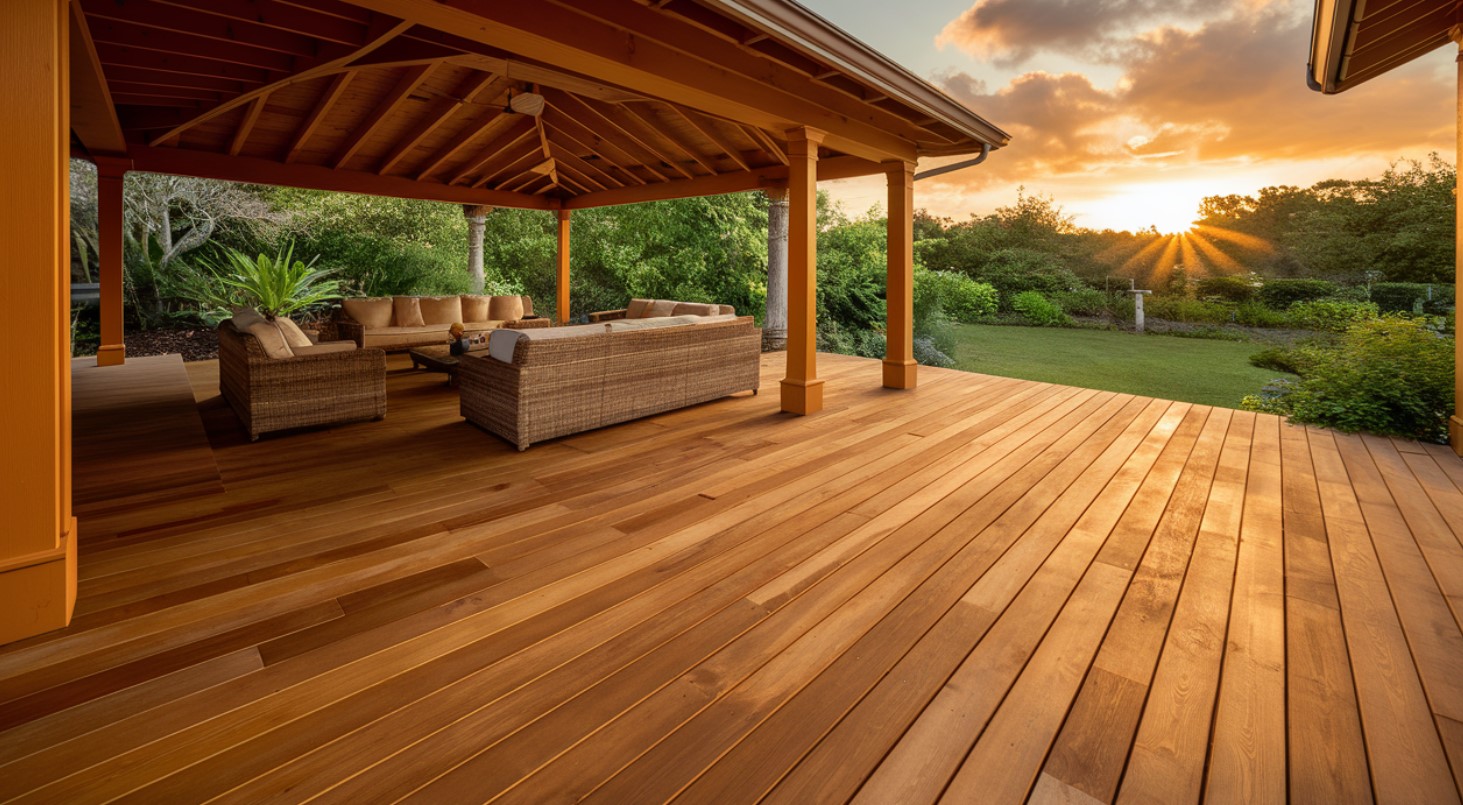
Environmental Considerations
When choosing between composite decking and wood, you should consider the environmental impact of each material. Composite decking often stands out as an eco-friendly option due to its use of sustainable materials. Many composite boards are made from recycled plastics and reclaimed wood fibers, contributing to green building initiatives. These recycling benefits mean that fewer new resources are extracted, reducing overall environmental impact.
In contrast, traditional wood decking, while natural, involves the harvesting of trees, which can have significant environmental consequences. The environmental impact of wood harvesting includes deforestation and habitat disruption. However, you can mitigate some of these effects by opting for responsibly sourced wood, such as FSC-certified timber, which promotes sustainable forestry practices.
Composite decking’s durability also adds to its environmental credentials. Since it lasts longer and requires less maintenance than wood, fewer resources are used over its lifespan. Conversely, wood decking often needs frequent treatments with chemicals that can be harmful to the environment.
Ultimately, composite decking provides a more sustainable choice with substantial recycling benefits, making it an excellent option for those prioritizing eco-friendly building practices.
Making the Right Choice for Your Home
Choosing between composite decking and wood for your home involves evaluating your specific needs and preferences. Consider your budget, the look you want to achieve, and how much time you’re willing to spend on maintenance.
Also, think about the climate in New Zealand, as it can impact the performance and longevity of your decking material.
Assessing Your Needs and Preferences
To determine the best choice for your home, start by evaluating how much time and effort you’re willing to dedicate to maintaining your deck. Composite decking requires minimal upkeep, while wood decking demands regular staining and sealing. Your design preferences, environmental impact concerns, maintenance requirements, durability concerns, and cost analysis all play important roles in this decision.
- Design preferences: Composite decking offers a variety of colors and finishes, whereas wood provides a traditional, natural look.
- Environmental impact: Composite decking is often made from recycled materials, making it an eco-friendlier option compared to natural timber.
- Maintenance requirements: Composite decking needs less maintenance, saving you time and effort. Wood, conversely, needs regular upkeep to avoid issues like rot and splintering.
- Durability concerns: Composite decking is more resistant to rot, mold, and insects, while wood can suffer from these issues over time.
- Cost analysis: Although composite decking has a higher initial cost, it can be more economical in the long run due to its lower maintenance expenses.
Budget
Evaluating the budget for your decking project involves considering both the initial costs and the long-term maintenance expenses. When you perform a cost analysis, you’ll notice that composite decking has a higher upfront price, around £7 per square meter, compared to traditional wood decking at approximately £21 per square meter. However, budget considerations shouldn’t stop there.
A thorough expense evaluation reveals that composite decking, while initially pricier, can save you money in the long run. Traditional wood decking demands consistent upkeep—sanding, varnishing, and painting—all of which add to your ongoing costs. On the other hand, composite decking requires minimal maintenance, freeing you from frequent and costly upkeep.
When conducting a financial comparison, it’s important to factor in these maintenance expenses. Over time, the lower maintenance costs of composite decking can offset its higher initial price.
A detailed price assessment shows that composite decking’s durability and resistance to rot, warping, and splintering provide long-lasting performance, making it a financially wise investment.
Desired aesthetic
When deciding on the desired aesthetic for your home, it’s important to weigh the traditional, natural charm of wood decking against the versatile, uniform look of composite decking. Wood decking offers a warm, rustic appeal that many homeowners love, but composite decking brings a consistent and modern appearance with various color options and texture differences designed to mimic real wood.
Consider these factors to make an informed choice:
- Color options: Composite decking comes in a wide range of pre-designed colors, whereas wood can be stained or painted, offering customization but requiring maintenance.
- Texture differences: Composite decking is manufactured to provide a uniform texture, while natural wood can vary greatly in grain and feel.
- Weather resistance: Composite decking is highly resistant to weather impacts, maintaining its look over time, whereas wood can weather and change appearance with exposure.
- Eco friendly choices: Many composite decking options are made from recycled materials, making them a more sustainable choice compared to traditional timber.
- Installation process: Composite decking often features easier installation with interlocking systems, whereas wood requires more precise cutting and fitting.
Maintenance willingness
When choosing between composite decking and wood, one of the key considerations is how much time and effort you’re willing to invest in maintenance. Composite decking offers significant maintenance benefits. It only needs occasional cleaning with soap and water, saving you substantial time and effort compared to traditional wood decking.
Wood, conversely, demands regular upkeep like staining, sealing, and even potential repairs to maintain its appearance and structural integrity.
When conducting a cost analysis, it’s clear that composite decking provides long-term savings. While the initial investment might be higher, the reduced need for ongoing maintenance translates into fewer expenses over time. You won’t have to buy stain, sealant, or replacement boards as frequently as you’d with wood.
In terms of effort required, composite decking is the clear winner. You can enjoy your deck more without the constant worry of rot, mold, or splintering. This makes composite decking ideal if you want to maximize your leisure time and minimize maintenance chores.
Ultimately, the time savings and long-term savings make composite decking a practical and efficient choice for homeowners seeking a low-maintenance outdoor space.
Climate Considerations in New Zealand
Choosing the right decking material for your home in New Zealand means considering the unique climate challenges that can impact durability and maintenance. New Zealand’s varying weather conditions, from coastal moisture to intense UV exposure, necessitate materials that can withstand these elements.
Composite decking offers several advantages over traditional wood with regard to climate resilience:
- Moisture resistance: Composite decking is less likely to absorb water, preventing mold and rot common in New Zealand’s coastal regions.
- UV protection: Unlike wood, composite materials are engineered to resist fading and degradation from harsh sunlight, reducing the need for frequent staining or sealing.
- Durability comparison: Composite decking is designed to resist warping, splintering, and cracking, providing long-lasting performance even in New Zealand’s diverse climates.
- Sustainability benefits: Often made from recycled materials, composite decking is an environmentally friendly choice that reduces the need for deforestation and frequent replacements.
- Low maintenance: With minimal upkeep required, composite decking saves time and effort, making it a practical choice for homeowners.
How local weather affects decking materials
Given your local weather conditions, understanding how humidity, heat, and precipitation affect decking materials is essential for making an informed choice. Weather impact on decking materials can greatly influence their durability and maintenance requirements.
Composite decking offers superior moisture resistance, making it an excellent option if you live in a region with high humidity or frequent rainfall. Its ability to resist water absorption means it won’t warp, rot, or splinter like traditional wood decking.
When considering your local climate, decking durability becomes a key factor. Composite decking also holds up well under harsh sunlight and extreme temperature changes, maintaining its color and structural integrity. On the other hand, wood decking may struggle with heat resistance, often warping or fading under intense sunlight and fluctuating temperatures.
UV protection is another important element in the composite vs. wood debate. Composite decking typically includes UV inhibitors that help protect it from the sun’s damaging rays, whereas wood decking can degrade and discolor over time without regular treatment.
Therefore, considering your local weather conditions, composite decking provides a low-maintenance, long-lasting solution that adjusts well to various climatic challenges, making it a smart choice for your home.
Frequently Asked Questions
Which Is Better, Composite Decking or Wood Decking?
When deciding between composite decking and wood decking, consider maintenance requirements, cost comparison, environmental impact, durability factors, and aesthetic preferences. Composite decking requires less maintenance, is more durable, eco-friendly, and can save you money long-term.
What Is the Downside of Composite Decking?
You’ll find composite decking’s downsides include higher initial cost, potential color fading, and heat retention. While it reduces maintenance requirements, its environmental impact and color variations might deter those seeking a consistent, eco-friendly option.
Why Is Composite Better Than Wood?
You’ll find composite decking superior to wood due to its weather resistance, aesthetic appeal, and longevity factors. It’s eco-friendly and requires less maintenance, making it a practical and sustainable choice for your outdoor spaces.
What Is Best, Timber or Composite Decking?
When choosing between timber or composite decking, consider environmental impact, maintenance requirements, cost comparison, installation process, and longevity factors. Composite decking offers lower maintenance, longer lifespan, and easier installation, but timber might appeal for its natural charm.
Conclusion
To sum up, choosing between composite and traditional wood decking hinges on your priorities. If you value low maintenance and durability, composite decking’s higher initial cost might be worth it.
Conversely, if you prefer a natural look and customization, wood decking could be the way to go, notwithstanding its upkeep. Consider your budget, aesthetic preferences, and how much time you’re willing to invest in maintenance.
Weighing these factors will help you make the best decision for your home.
